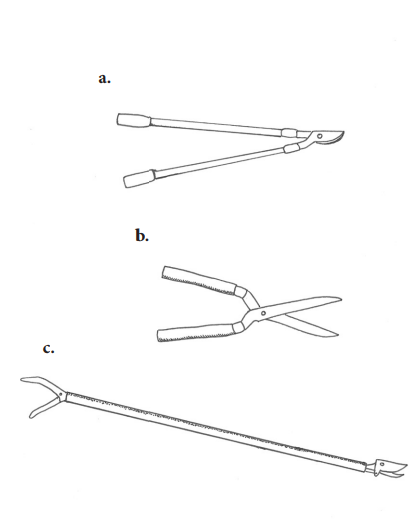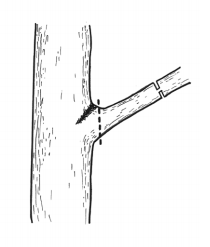The main objectives of pruning trees should be to create and preserve good structure, and to correct storm damage or other problems that develop during the tree’s lifetime. Proper pruning and training when trees are young encourages the development of strong branches and an attractive, balanced framework. This formative pruning will help minimize the amount of time and labor required to care for trees later on.
When selecting and planting shade trees, carefully consider their mature height and spread. Trees that grow too large for the site where they’ve been planted often require continuous and severe pruning to constrain their size, and will remain an ongoing maintenance problem until they are removed or replaced. When a tree is planted in an appropriate location, it can be allowed to grow according to its natural habit, and it will ultimately require less care and pruning.
Small trees can be successfully pruned in the home landscape up until a certain point. Once trees become too large to prune from the ground, it is worth considering hiring a professional arborist to do the pruning safely and properly.

Pruning Tools
Using the proper tools for the job is a key part of pruning. Most experienced pruners will utilize multiple tools depending on the size and placement of the branches they are cutting.

Pruning shears (hand pruners) can be used on branches that are up to a half-inch in diameter and come in two separate styles. Bypass pruners are best used on living branches because, like a pair of scissors, they make clean, close cuts that heal faster. Anvil pruners on the other hand have a single blade which connects against a solid plate. These are not recommended for live wood because they crush stems, although they can be useful for quickly clipping dead branches.
Loppers have long handles and are operated with both hands. They can be used to quickly cut small branches and stems that are up to one inch in diameter. Be aware that trying to make larger cuts with loppers can lead to bark damage.
Hedging shears should only be used for pruning hedges, topiaries, and other formal shapes. There is rarely any need to use hedging shears on deciduous shrubs. Although shearing is faster than hand pruning, selective hand pruning is much better for the plant and results in better structure in the long term.
Pruning saws come in many different styles and can be used for branches that are larger than ½ in diameter. The cutting edge of a saw is measured in points (teeth per inch). The most common general-purpose pruning saws have six-points and can be used for cutting small limbs. An 8-point saw, such as an apple saw, is most desirable for delicate, close work, and a 4 ½ point saw is most efficient for pruning large, heavy limbs. Some have fixed handle blades, while others fold-up for easy transport and storage. Hand saws can also have either straight or curved blades. Curved blades that cut on the pull stroke are more efficient for removing large branches, whereas straight blades are best for small, detailed cuts.
Pole saws and pruners are important for reaching some tree limbs or high branches of evergreens. Cutting blades are attached to poles that are either telescoping or jointed together in sections. Fiberglass or plastic poles are best because they are lightweight. Chainsaws can also be useful pruning tools for removing large branches or entire plants, but they should only be used by experienced operators.
DID YOU KNOW? Although shearing is faster than hand pruning, selective hand pruning is much better for the plant and results in better structure in the long term.
Tool Care
Just as selecting the right tools is important, so is taking proper care of them. All pruning tools should be kept as sharp as possible in order to make clean cuts. Branches with clean pruning cuts are more likely to heal properly than those that are crushed or ragged from dull tools.
Sanitation
Introducing or spreading disease can be a concern when pruning. While most diseases aren’t spread by pruning tools, a few can be. One of the best ways to guard against infection is by dipping or wiping pruning tools with isopropyl alcohol or a 10% bleach solution (nine parts water, one part bleach) between cuts, especially when moving between related healthy and diseased trees. Furthermore, it is a good idea to prune healthy trees first and diseased trees last.
Training and Pruning
Select shade trees from garden center or nursery that have already been trained to have a central leader (one trunk) with radial branches evenly spaced along the trunk (unless it is a specimen tree with an unusual growth habit). The pruning guidelines described below do not apply to special forms including trees with weeping habits, contorted trunks, or top-grafted specimens.
Do not prune trees at planting or during the first year of growth, except to remove competing leaders if necessary, or to remove dead or injured branches. The following year, resume selective training and branch removal to achieve good vertical branch spacing and radial branch distribution (Figure 1 and 2).
Choose a strong branch, with a good connection to the trunk for the first permanent branch. It should be growing away from any structures or obstructions. It may be 4 or 5 feet from the base, or even higher if people or vehicles will need to pass underneath the mature tree.
Branches below the first permanent branch are temporary branches that will be removed as the tree grows. Allowing these short, small diameter branches to remain as long as possible helps form a strong trunk. You can head temporary branches back to a foot or less in length so they don’t get in the way. Remove them with a proper pruning cut before they reach ½” in diameter.
More branches above the first permanent branch should be selected as the tree grows. As with lower temporary branches, you can allow some temporary branches at closer spacing, but remove the weaker branches when they become too large and crowded.
Begin by making cuts necessary for good tree health and to maintain a strong, straight central leader. First remove broken, dead, crossing and pest-infested branches. Remove branches growing vertically (competing with the main leader), water sprouts, and temporary branches which are getting too large. Encourage the tree to grow in its natural form while selecting healthy branches that have strong crotch angles and are radially distributed around the trunk. On mature shade trees, the vertical branch spacing along the trunk should be 12” or more (Figure 1).

Radial branches should grow outward from the trunk in a spiral pattern so that the form is balanced and maximum light penetration is allowed (Figure 2). Radial spacing prevents one limb from competing with another for light and nutrients.

When deciding which branches to remove, select those that are weak and those that have a narrow crotch angle (Figure 3). The strongest branch to trunk connections, with the least potential for breaking from storm damage or other stresses, are those at 60 and 70 degree angles from the trunk.
If pruning to reduce the size or spread of the tree, reduce long branches by cutting back to shorter ones.

DID YOU KNOW? Unlike people, trees are unable to heal damaged tissues. Instead, they compartmentalize wounds with layers of cells and by producing defense compounds that help prevent the damage from spreading any further.
Making Proper Pruning Cuts
Unlike people, trees are unable to heal damaged tissues. Instead, they compartmentalize wounds with layers of cells and by producing defense compounds that help prevent the damage from spreading any further. The angle of pruning cuts impacts how well a tree will be able to grow over an injury. The proper angle of a cut can be determined by carefully observing two branch features, the branch collar and the branch bark ridge.
The branch collar is a swollen area where the tissue of the main trunk connects with the branch tissue. The branch bark ridge is an area of raised bark found above branches where the bark on the stem meets the bark on the branches. Inside the branch collar is a ring of cells that form callus tissue called woundwood that helps isolate wounds and protect them from decay organisms.

Branches should be pruned just beyond the branch collar to encourage proper healing. When there is no obvious branch collar, the branch should be removed at roughly the same angle as the branch bark ridge. Preserving the branch collar is critical to ensuring the formation of woundwood and limiting wood decay. Woundwood is able to overgrow small cuts quickly during the active growing season, but large cuts may never develop a layer of woundwood over the entire wound.
Flush cuts that remove the branch collar or damage the branch bark ridge limit the growth of woundwood, leaving tees with poorly sealed wounds that invite decay organisms into the trunk. Leaving branch stubs is also undesirable, because stubs act as physical obstacles to wound closure. Heading cuts are often unable to develop woundwood and are subject to decay.
Large Branch Removal
When removing large branches from trees, it is very easy to tear the bark on the trunk unless the weight of the branch is first removed. In order to avoid causing any unnecessary damage, start by making the first cut on the underside of the branch about one foot from the trunk. The first undercut should go about 1/3 of the way through the branch. Make the second cut directly above the first cut and remove the branch, then remove the remaining branch stub by cutting at the outside edge of the branch collar.


THINK SAFETY: Wear a hard hat and goggles when pruning large trees, especially when using a pole pruner. Do not prune near utility lines! Pruning mature trees or removing large limbs, is best done by a professional tree care company.
When to Prune
In general, prune shade trees when dormant, during late winter or spring prior to budbreak. Extensive pruning during shoot growth and leaf expansion in late spring, or other active growth periods, can place a tree under stress, and/or may generate an excessive number of water sprouts (unbranched vertical shoots). These water sprouts then should be removed during the growing season.
Dead or broken branches can be removed anytime and removing an occasional limb during fall or winter will have little impact on the health of a tree. Avoid routine pruning in late fall or winter, however, as cambial growth will not be active to close over the pruning cut; consequently, extreme cold temperature may kill the exposed tissue.
Although sometimes unsightly, bleeding from pruning wounds is normal and is not an indication of harm to the tree.
In decades past, recommendations were often made to apply tree paint to wounds. The idea was that this paint would prevent decay, help speed healing, and improve the appearance of the cut. However, in reality, pruning paint may impede the trees natural defenses and encourage the growth of rot organisms. In most cases, it is best to simply leave pruning wounds alone.
About the Author Original fact sheet by David Seavey, UNH Extension Educator Emeritus. Revised February 2019 by Jaime Roberge, Emma Erler, and Cathy Neal. Illustrations by Emma Erler